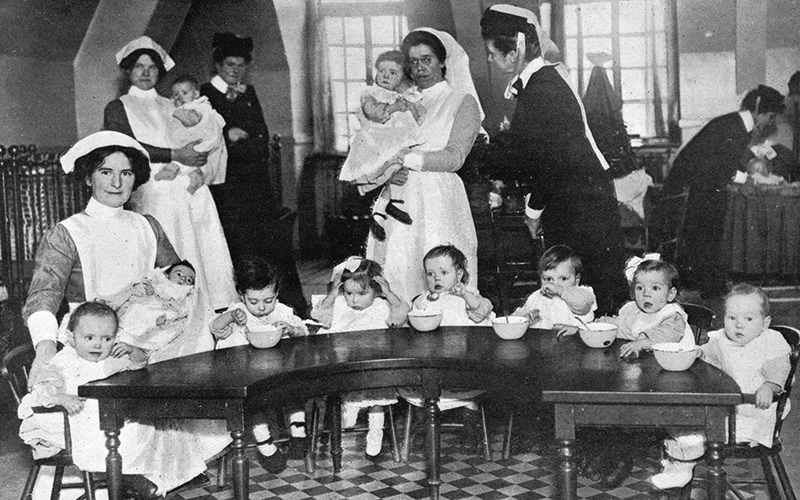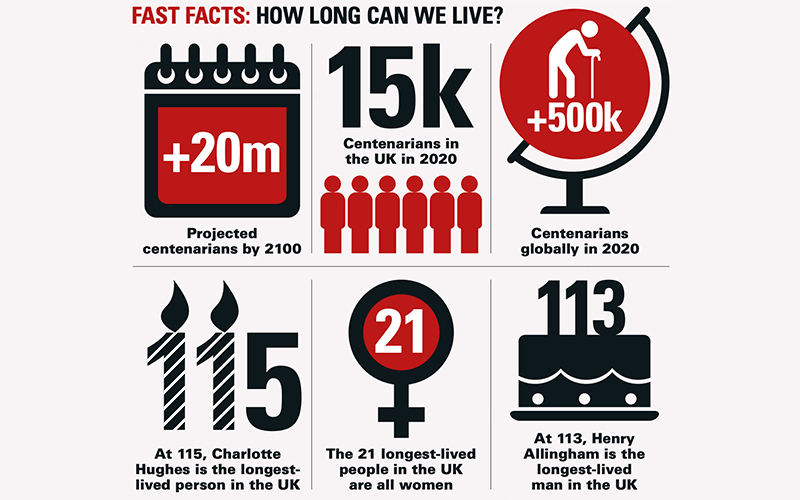It has been 25 years since Jeanne Calment, the oldest person to have ever lived, passed away. In the decades since, no one has come close to her 122 years. Here we investigate whether research projects and advances in medicine can increase lifespan indefinitely, or if we have hit the limit.

When Jeanne Calment was born in 1875 in France, the life expectancy for a baby girl in a relatively advanced country was around 45 years old, and perhaps another 15 years or so if she made it through childhood and giving birth to her own infants.
In the event, Calment far exceeded the expectancy and made it to her 122nd birthday – she still holds the record for the longest-lived person and remains an outlier among centenarians – her closest rivals managing just 119 years (though at the time of writing one of those, Kane Tanaka in Japan, is still clocking up the days, weeks and months).
By the time Calment died in 1997, much of the world had changed beyond recognition, and the same life expectancy figure for a female, from birth, had soared to just over 80 years. Another 25 years later, the average life expectancy for a French woman is more like 85, with men a little bit behind.
Back in 1875, few people made it to their 80s and centenarians were more or less mythical figures. But here in 2020, official estimates put the number of centenarians in the UK alone at around 15,000, with a global count of anywhere between 500,000 and a million. The projected figure for 2100 is put at 20 million to 25 million.
The recent surge in centenarian numbers reflects the spike in birth rates in the years immediately following the end of World War One, but the more influential factors behind the trend for greater longevity are of course vastly improved living standards and the extraordinary advances made in health and medicine during the 20th century and since.

This rush of progress has shown that controlling environmental factors and addressing key physiological aspects, from fighting simple infections to conducting complex organ transfers, can significantly extended the human lifespan. We know it can be done, which now raises the more relevant question: just how far can the human lifespan be extended?
Given that nobody in more than two decades since Jeanne Calment’s death has exceeded her milestone of 122 years, we may already have seen the natural limit to what can be achieved. But ongoing advances in research and our understanding of what triggers the events that unfold during the ageing process may also expand the horizon of possibility.

What is ageing?
Some experts argue that ageing is best thought of as a disease in itself, the jumping-off point for all the other conditions that we associate with ageing, such as cancer, atherosclerosis, diabetes, dementia, osteoporosis, macular degeneration and so on. Perhaps it is better to understand it is as an agglomeration of interrelated and seemingly inevitable genetic and biological processes that upset the careful physiological balance of an organism such as the human body, limiting its function, leaving it vulnerable to other internal and external forces, and leading to further decline.
“The many research projects promise to unlock further secrets of ageing”
Many of these processes are focused on the reproduction of cells. One of the key factors here is the genetic damage that gradually accumulates as time goes on and with each division of the cells. The DNA contained in the old cells should copy over perfectly to the new cells, but it doesn’t, it mutates, and to deal with this the body mobilises a DNA repair system that utilises proteins and enzymes to control any wayward replication. All well and good, but excessive levels of these molecules can be harmful, leading to the depletion of other substances crucial to controlling DNA and cell replication, which allows mutations to proliferate.
Related to this, the number of dead or senescent cells in our bodies rises as we get older, and these create an inflammatory response. The immune system is tasked with flushing these cells out, but it too begins to degrade as the body ages and has to work harder and harder to fight off all the other encroaching threats let alone eliminate the senescent cells. As senescent cells accumulate further, the inflammation intensifies, triggering all sorts of tissue damage, from skin wrinkles to hardened arteries.
Another key cellular process linked to ageing is telomere shortening. Telomeres are part of the chromosome that carries no genetic information. In most cells, telomeres are gradually eroded with each replication. This is problematic because they help to shield the DNA information, but without that protection the DNA is left open to degradation.
Yet another factor is metabolic decline, when the body becomes less efficient at processing energy, which is associated with changes in body composition and reduced levels of key hormones. Unfolded proteins are also linked to the ageing process: the function of each protein is often determined by its unique shape, but if that shape is compromised – that is, it unfolds – it cannot carry out its vital work within the cell, and as a consequence the cell malfunctions. Research suggests this process is related to various age-related diseases, and particularly those centred on the brain and nervous system, such as Alzheimer’s and Parkinson’s.
Research projects
Of course, this is just a simplified snapshot of the many complicated, interwoven processes at work during ageing. But the many research projects currently investigating cell division and DNA replication promise to unlock further secrets of ageing. For example, proteins are the subject of some of the most recent published research on the causes of ageing. A team at the University of Edinburgh looked at the results of genetic information on hundreds of thousands of people who had taken part in major studies on ageing. From the data on more than 800 proteins, they identified two that had an especially marked impact across all the measures of ageing. High levels of the first of these proteins, apolipoprotein(a) (LPA), were seen to raise the risk of atherosclerosis, while the second, vascular cell adhesion molecule 1 (VCAM1), which helps the immune response and blood clotting, could have an impact on cognition.
Appropriate drugs to combat high levels of these proteins have the potential to extend lifespans. Other research has shown that by deleting senescent cells the lifespans of mice could be lengthened by up to 25%. Meanwhile, the thinking on telomere shortening is that with the careful application of the enzyme telomarase, the telomeres needn’t shorten at all and that as well as preventing cell destruction it might even rejuvenate damaged tissue – care is needed, though, as it’s the same enzyme that allows cancer cells to divide endlessly without breaking down.
Even these few strands of current research demonstrate that as our understanding of the mechanisms of ageing improve, so too does the potential for tweaking them, adjusting them, and slowing them down. It’s not hugely different to the previous medical advances that have increased human lifespans, just on a much finer and intricate scale, where the secrets may be harder won but promise even greater rewards.
Natural constraints
So who is to say that if we could address the overall process of ageing and its various sub-routines with effective, targeted drugs and other therapies, while engineering the lifestyle and environmental factors (poverty, stress, pollution, mental health, bad food and so on) to be as benign as possible, that the human lifespan couldn’t extend far beyond what we see at the moment?
One group of naysayers from the Albert Einstein College of Medicine in New York published a much-discussed paper in October 2016 that argued the average human lifespan was unlikely to exceed much more than 115 years. They looked at global data on life expectancy and population trends from 40 countries since 1900 and concluded “our results strongly suggest that the maximum lifespan of humans is fixed and subject to natural constraints”.
While some experts in the field supported their findings, others were less charitable, criticising the methods used and the assumptions made. The titles of the follow-up briefing papers tell their own stories: “Questionable evidence for a limit to human lifespan” and “Many possible maximum lifespan trajectories”.
“With millions set to become centenarians in the years to come, the 122 years achieved by Jeanne Calment will become more of a routine”
While the human body appears to have a degree of built-in obsolescence, with everything slowing down under the weight of internal stresses and external pressures, the latest research suggests that, as with any machine, a regime of proper care and maintenance, a replacement part here and there, and an injection of super new lubricating fluid, it could run for much longer.
It’s a comforting thought that with the right interventions we could look forward to a longer life and an expanded human experience.
Already buckling
But if we accept the notion that human life can be extended even further, we also have to confront the question of the quality of life. Is extending human lifespans desirable when there is already so much pressure on the planet’s natural resources and economic systems, when healthcare provision is already buckling under the weight of an ageing population’s multiple morbidities?
Would it not be better to concentrate on improving the quality of life of the “normal” age range rather than attempting to stretch what is feasible? The likely answer is that by addressing the first, by continuing to focus on the fundamental mechanisms of ageing and the related diseases, such as cancer and heart disease, the second will come naturally, and with many millions of people set to become centenarians in the years to come, the 122 years achieved by Jeanne Calment will become more of a routine than an exception.
Image Credit | Richard Gleed | Alamy
